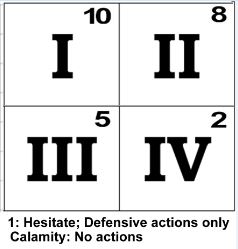The West That Wasnt - Basic Initiative and Speed Rules
The chips are down, the gauntlet has been tossed, all of the cliches are past. The time for action is now, and the first step in adjudicating action is determining the order. What follows is an overview of how to do that. More specific questions can be found in the Advanced Action Time section.
Once the Judge has painted the scene, all players need to determine what their Heroes will do. This all begins with a declarations phase. Players need not decide exactly what they will do at this time, all that is important is the general class of action, and whether they will use their full allotment of actions.
Contents
Declarations
In TWTW, a declaration is a general indication of the class of action the character will perform, and also whether the full action allotment will be used. Players have tokens to represent the action classes as well as the allotments. To make a declaration, place the two appropriate counters face down on your character sheet. Once the counters are laid, the player may draw a card to determine timing. Once a card has been drawn, no changes may be made to the counters.
Determining Initiative
Initiative determination is a simple Reflexes check. Each Phase (I-IV) has a TN based on whether the character is using their full action allotment. It takes longer to use your full allotment, therefore, doing less increases the chance you will go earlier in the round.
On the character sheet is an Initiative Grid.
Beneath the grid is a list of TNs for each Phase listed by action speed.
Compare the result from the Reflex check to the TNs for each phase and place the counter stack inside one box for which the result is equal to or greater than the given TN. This is the phase where the character will act this round. Once placed, the counters may not be moved.
EXAMPLE
Action Classes
The range of possible actions a character can perform during an action scene is virtually limitless. In TWTW, actions are classified into one of five broad categories for ease of adjudication and clarity. When rules refer to an action category, they apply to any action which qualifies.
The five classes of action are Maneuver, Attack, Advance, Tactical Movement and Freestyle. A maneuver is any action that includes movement but not an attack. An attack is any action that includes an attack, but no movement. An advance is an action combining a movement with a hand to hand attack. A tactical move is a movement combined with a ranged attack. Finally, a freestyle maneuver is anything that is not covered by the previous four categories.
Why Classify Actions?
You may wonder why it is important to group actions into broad categories, and you may also wonder what benefit it has during the game. By combining actions into groups, we, the designers, are able to easily create rules and guidelines that apply to some types of actions, but not others, without needing to explain within each individual rule where it is applicable. It is our view that by creating easy to understand division between action types we can make rules that are clearer and easier to understand, while also being able to keep them differentiated so players know when rules apply and when they do not.
There are also tactical and gameplay reasons behind the classification system. These will be discussed further in the advanced rules.
Maneuver
During a maneuver action a character uses some form of movement to move at least one pace. They may or may not do another action, though they expressly may not use an attack. See movement rates in the Conflict section for more on movement.
EXAMPLE
Attack
An attack action is any action that includes a ranged attack, but no movement of any kind. Note that in the Maneuver action, above, movement is defined as moving at least one pace. A character may duck behind cover, drop to the ground, mount or dismount a horse or otherwise move without technically using movement.
EXAMPLE
Advance
An advance is any movement combined with a hand to hand attack. This may be an armed or unarmed attack. Other actions may also be combined, such as drawing a weapon.
EXAMPLE
Tactical Move
A tactical move is a movement combined with a ranged attack. This may also include aiming, cocking or readying a weapon, if applicable.
EXAMPLE
Freestyle Action
A freestyle action is anything that is not covered above.
